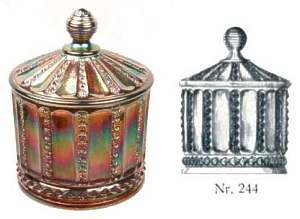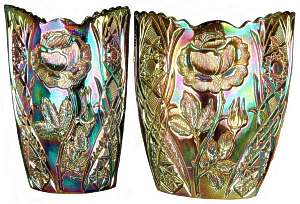The Story of Fr. Wilhelm Kutzscher - mould designer and mould maker
All our research to date on Kutzscher and their pattern designs, with grateful thanks to Dieter Neumann
for additional research and fascinating insights into this company.
for additional research and fascinating insights into this company.
Oil Cans, Chocolates and … Carnival Glass
In 2012, our research into Carnival Glass made in Scandinavia led us into a study of Friedrich Wilhelm Kutzscher, a firm that designed and made moulds and specialised machinery for the glassmaking industry. At that time, we had already made a positive link between moulds made by Kutzscher and the Carnival Glass patterns made by Eda Glasbruk and by other glassmakers (and we first published our discoveries in our ebook trilogy in 2012-13).
Our continuing research has been greatly assisted by Dieter Neumann, who has sourced and made available, some amazing Kutzscher catalogues that show not only moulds and machines, but also provide fascinating insights. It is clear that Kutzscher had a major impact on the glass making industry in general, and on the production of Carnival Glass in Europe in particular.
Background
Dieter explains that the company was founded in 1879 in Schwarzenberg (in the Erz Mountains) by Friedrich Wilhelm Kutzscher. It was known as "F.W.Kutzscher jun." and it was used for the production of metalware of drawn, pressed, punched and embossed objects (moulds). In 1904, Kutzscher began producing moulds for chocolate confectionery here too. The following year, Kutzscher acquired another metal mould producer, August Riecke which was a maker of specialised machines for the glass industry and moulds for both glass and chocolate making.
Kutzscher’s second company was known as "Fr. Wilhelm Kutzscher". In 1908 Kutzscher then founded a third company "Fr. W. Kutzscher & Co." in Obersachsenfeld near Schwarzenberg. At this factory, porcelain tableware, knick-knacks and souvenirs were produced – interestingly, most of these souvenir items were exported to Great Britain as "crested china".
In 2012, our research into Carnival Glass made in Scandinavia led us into a study of Friedrich Wilhelm Kutzscher, a firm that designed and made moulds and specialised machinery for the glassmaking industry. At that time, we had already made a positive link between moulds made by Kutzscher and the Carnival Glass patterns made by Eda Glasbruk and by other glassmakers (and we first published our discoveries in our ebook trilogy in 2012-13).
Our continuing research has been greatly assisted by Dieter Neumann, who has sourced and made available, some amazing Kutzscher catalogues that show not only moulds and machines, but also provide fascinating insights. It is clear that Kutzscher had a major impact on the glass making industry in general, and on the production of Carnival Glass in Europe in particular.
Background
Dieter explains that the company was founded in 1879 in Schwarzenberg (in the Erz Mountains) by Friedrich Wilhelm Kutzscher. It was known as "F.W.Kutzscher jun." and it was used for the production of metalware of drawn, pressed, punched and embossed objects (moulds). In 1904, Kutzscher began producing moulds for chocolate confectionery here too. The following year, Kutzscher acquired another metal mould producer, August Riecke which was a maker of specialised machines for the glass industry and moulds for both glass and chocolate making.
Kutzscher’s second company was known as "Fr. Wilhelm Kutzscher". In 1908 Kutzscher then founded a third company "Fr. W. Kutzscher & Co." in Obersachsenfeld near Schwarzenberg. At this factory, porcelain tableware, knick-knacks and souvenirs were produced – interestingly, most of these souvenir items were exported to Great Britain as "crested china".
|
A magnificent series of buildings – Friedrich Wilhelm Kutzscher’s empire in 1924.
|
|
A - F. W. Kutzscher jun: the old factory.
B - F. W. Kutzscher jun: the new factory, 1910. C - Fr. W. Kutzscher & Co. (chinaware). D - Fr. Wilhelm Kutzscher in Deuben - Dresden (the August Riecke factory). |
Which Carnival Glass makers used moulds made by Kutzscher?
Our research has shown that many Carnival Glass moulds were produced by Kutzscher, and were used by glassmakers such as Eda (in Sweden), Riihimaki (in Finland) and Hortensja (in Poland). Information from Dieter Neumann has further shown that glass making machinery was supplied by Kutzscher to a huge number of glass making companies, including Rindskopf (in Czechoslovakia), Riihimaki, Cristalerias Papini (in Argentina), the Swedish Glass consortium (which included Eda Glasbruk) and the Australian Glass manufacturers in Sydney (Crown Crystal Glass).
In the Kutzscher Design Gallery, we show items that were made by these companies and the corresponding Kutzscher designs.
Kutzscher (with Riecke) was a major business: to appreciate the significance of Kutzscher's impact, it is important to know two crucial and fundamental points:
Kutzscher was NOT a glassmaker.
Kutzscher’s “catalogue” is actually a book of pattern designs and ideas for pattern designs.
The Kutzscher / Riecke catalogues contained drawings of possible designs – they were not representations of actual moulds. Their illustrations were neither moulds, nor actual glass pieces. They were books full of ideas, books of proposals, showing what kinds of things could be done. Not all the designs featured would have ever been made in moulds / actual glass. Many designs would have been modified (at the glassmakers' request). Some of the designs would never have even progressed beyond the design stage, remaining forever just lines on a page.
|
Riecke's 1905 book of designs is a fascinating document featuring around 250 different patterns, several of which may be familiar to Carnival Glass collectors.
Kutzscher used this portfolio as a starting point and introduced more designs, so that by 1910, the new Kutzscher design book offered well over 700 different patterns (and some of them appeared in many different shapes and forms). Between 1910 and 1924, another 400 or so designs would be added by Kutzscher’s graphic design team. Kutzscher's design promise. Although they had a huge range of pre-drawn designs and pattern/shape design ideas, they specifically urged their customers to be creative - to add their own touches to these designs, or even to submit their own ideas. The drawings in the design books provided the starting blocks for the customers’ further ideas, but they also offered the customer a blank page, inviting them to commission their own specific design. Here’s how Kutzscher offered this service: “Should you not find in this catalogue the things you require, please be so kind and let me know your particular wishes.” Unsurprisingly from what we know generally about glassmakers of that era, Kutzscher could, and did, copy other maker’s designs, to meet a customer’s requirements. Naturally, this invited plagiarism, but bear in mind that this was absolutely typical of the time. As Riecke so pointedly phrased it in 1905: “Every mould exactly made according design or sample sent by glass manufacturers”. So, customer X could send Riecke a piece of glass made by Y glass, and say “make me a mould that looks like this”! It is important to realise that only a few actual glass items are going to be identical to the Kutzscher designs in the pattern book. As we show in subsequent pages, glassmakers did like to add their own touch, their own stamp of individuality and creativity. Indeed, in one case (the Stjarna bonbonniere by Eda) it appears that the design features of two separate Kutzscher drawings were combined! |
Above: from Riecke’s 1905 catalogue.
Courtesy Siegmar Geiselberger and Alexander Nestler |
Specialist glassmaking machinery.
Not just moulds then? Machines to make glass … this was where Kutzscher really excelled …as producers of machines for glass making. When they took over August Riecke in 1905, they also acquired a comprehensive engineering shop (from foundry to finished product) producing top notch glass-making machinery.
Side lever presses, special machines for blow-moulding and press-moulding combined, grinding machines, etching machines, and much more besides. Everything the glass industry needed to make its finished products. Fr. Wilhelm Kutzscher wrote (in the company’s 1912 Machine catalogue) that he had an “excellent and up-to-date plant and foundry, supported by a skillful staff.” Records show that Eda Glasbruks purchased machines as well as moulds from Kutzscher.
Not just moulds then? Machines to make glass … this was where Kutzscher really excelled …as producers of machines for glass making. When they took over August Riecke in 1905, they also acquired a comprehensive engineering shop (from foundry to finished product) producing top notch glass-making machinery.
Side lever presses, special machines for blow-moulding and press-moulding combined, grinding machines, etching machines, and much more besides. Everything the glass industry needed to make its finished products. Fr. Wilhelm Kutzscher wrote (in the company’s 1912 Machine catalogue) that he had an “excellent and up-to-date plant and foundry, supported by a skillful staff.” Records show that Eda Glasbruks purchased machines as well as moulds from Kutzscher.
Two of Kutzscher's machines for making pressed glass, from their 1912 Machine Catalogue - their "Excentric" and "Small Glass" presses.
Courtesy Siegmar Geiselberger
Courtesy Siegmar Geiselberger
With grateful thanks to Siegmar Geiselberger, Pamela Wessendorf, Dieter Neumann and Alexander Nestler, Glasmaschinenbau Freital GmbH.
Mouldmakers played a vital part in glassmaking, and often their contribution goes without due recognition.
We are pleased to recognise the significant contribution that was made by Friedrich Wilhelm Kutzsher and by August Riecke. In our continuing series "Unsung Heroes" we also record the vital work of people like Stephen Hipkins (mouldmaker) and Percival Marson (glass chemist).
In the following sections of our four page feature on Kutzscher we look specifically at:
Kutzscher Designs: The designs that were born in glass.
Kutzscher and Brockwitz: Original or Inspired designs?
Kutzscher - Some Questions: We investigate.
Click on any image below
Mouldmakers played a vital part in glassmaking, and often their contribution goes without due recognition.
We are pleased to recognise the significant contribution that was made by Friedrich Wilhelm Kutzsher and by August Riecke. In our continuing series "Unsung Heroes" we also record the vital work of people like Stephen Hipkins (mouldmaker) and Percival Marson (glass chemist).
In the following sections of our four page feature on Kutzscher we look specifically at:
Kutzscher Designs: The designs that were born in glass.
Kutzscher and Brockwitz: Original or Inspired designs?
Kutzscher - Some Questions: We investigate.
Click on any image below







